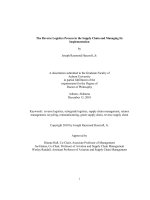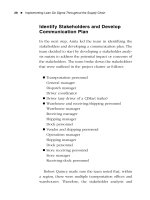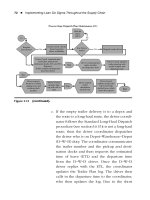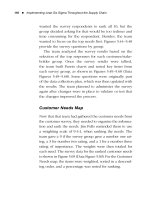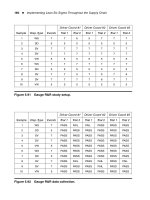THE ROLE OF MERCHANDISER INMANAGING THE SUPPLY CHAIN
Bạn đang xem bản rút gọn của tài liệu. Xem và tải ngay bản đầy đủ của tài liệu tại đây (1.34 MB, 55 trang )
This Thesis comprises 15 ECTS credits and is a compulsory part in the Master of Industrial
Engineering with a Major in Applied Textile Management, 60 ECTS credits
THE ROLE OF MERCHANDISER IN
MANAGING THE SUPPLY CHAIN
Mater Thesis No 2010.9.5
Saqib Ali
Zeeshan Ali
II
The Role of Merchandising in Managing the supply Chain
Saqib Ali ()
Zeeshan Ali ()
Master thesis
15 ECTC credits
Subject category
Applied Textile Management– Industrial Engineering
Series and number
ATM 5/2010
Bryggaregatan 17 The Swedish School of Textiles:
University of Borås
501 90 Borås, Sweden
Telephone: +46-33-435 40 00
Supervisor
Jan Carlsson ()
University of Borås
Examiner
Heikki Mattila ()
University of Borås
Date
May 20010
Keywords
Merchandising, Supply Chain, Management, Retailer, Buying, Agents, Textile Mills
III
Acknowledgement
It is hard to express that how fortunate we feel to be a part Swedish school of Textiles”, for
giving us an elegant project. The thought behind any research project of students is the
development of student’s educational skills and imaginative judgments. Such a thought has
been implemented in bringing out this thesis, in which we have tried to keep our focus on
discovering our skills.
There are few names that need mention here for the wonderful support they handed us in
our efforts. Our heartiest thanks go to Mr. Håkan Torstensson, Vice Director and also our
research supervisor MR Jan Carlsson for his guidance, meticulous care, valuable suggestions
and stimulating discussions. It would be unwise if we don’t honour the helping hands of our
friends in our class. Their uncountable efforts in front and behind the scene, made it possible
for us to slide through the task. Our sincere thanks go to Mr Martin Brink, managing director
and Mr. Niklas Odequis Purchase Director of Hemtex. These are the people who shares their
Experience and given us faith to be motivated for this uphill task. Besides we are also very
much grateful to our parents their proficient help and suggestions.
We are highly obliged to the merchandisers of Mills and Buying Houses that we have
contacted for the data collection. We also thank all our friends from Pakistan, for their
support for composing this thesis. In the end; we would like to thank the Almighty, who gave
us the strength and determination to carry on. It has been a majestic experience for us and
we end this note on this belief, that our project will surely help us in shaping our future.
,
Saqib Ali, Zeeshan Ali
May, 2010
IV
ABSTRACT
This research project is based on observing and analyzing the role of a textile merchandiser
in managing the supply chain of the Home textiles in the Buying or retailing, in the mills and
with the Agents. The project also highlights the comparative analysis of the practices
followed by merchandisers in the retailer side, mills and those in the Agents, on the basis of
the functions which supports the supply chain. In the discussion, we have highlighted
importance of the Role played by an Agent and by the merchandisers of Buyer and supplier
in different situations. By our research work we find out the challenges face by
merchandisers and then we come up with some suggestions.
This research project has been developed by contacting and visiting Hemtex, Brink Textiles,
by interviewing the merchandisers working in the industries like Al-Abid Silk mills. By
analyzing the information and the data through the visits and the interviews, this research
project has been combined to give in-depth knowledge about the activities which
merchandisers perform in a mill and in a buying house.
Keywords
Merchandising, Supply Chain, Management, Retailer, Buying, Agents, Textile Mills
V
Table of Contents
Acknowledgement III
ABSTRACT IV
Figures VII
Tables VII
1. Introduction 1
1.1 Purpose 1
1.2 Background 1
1.3 Delimitation 1
2. Methodology 2
2.1 Research Strategy 2
2.2 Structure of the Thesis 4
3. Literature Review 5
3.1 Historical Background of Supply chain 5
3.2 Introduction to Demand and Supply Chain Management 6
3.3 Historical Background 7
3.4 Modern Demand and Supply Chain Management Systems 7
3.5 Tools of Managing a Supply Chain Management System 8
3.6 Trends in supply chain 10
3.6.1 Communication 10
3.6.2 Technologies 10
3.6.3 Lead time 10
3.6.4 Outsourcing 11
3.6.5 Mass customization 11
3.6.6 Postponement 11
3.6.7 Cross Docking 12
3.6.8 Vendor Management Inventory 12
3.6.9 Enterprise Resource Planning (ERP) 12
3.7 The Concept of Textile Merchandising 13
3.7.1 Retail Merchandise 13
3.7.2 Textile Mills and Buying House 14
4. Case Companies 18
4.1 Hemtex AB 18
4.1.1 Introduction 18
VI
4.1.2 Importance of sourcing for Hemtex 20
4.1.4 Selection of the supplier 22
4.1.5 Swot Analysis 23
4.2 Brink Textile 25
4.2.1 Introduction 25
4.2.2 Responsibilities 26
4.3 Li & Fungs Group 27
4.3.1 Responsibilities 27
4.4 Al-Abid Silk Mills 29
4.4.1 Organizational Structure 29
4.4.2 Merchandising at Al Abid 30
5. Comparative Analysis 35
6. Discussion 41
7.2 Challenges face by merchandising and sourcing departments 42
7.2.1 Risks of global out scouring 43
7.2.2 Suggestions 44
7.3 Information flow problems and suggestions 44
7. Conclusion 46
8. Bibliography 47
VII
Figures
Figure 1Structure of the Thesis 4
Figure 2 Typical supply chain 6
Figure 3 Traditional merchandising structure 13
Figure 4 Flow chart of merchandiser activities 15
Figure 5 Departmental structure on the basis of customers 16
Figure 6 Departmental structure on the basis of products 17
Figure 7 Departmental structures on the basis of geography 17
Figure 8 Hemtex Management 18
Figure 9 Organizational supply chain structure 19
Figure 10 Product design & development structure 20
Figure 11 Swot Analysis of Hemtex 23
Figure 12 Brink Textile Organizational structure 25
Figure 13 Li & Fung Supply chain structure (Our Business) 28
Figure 14 Supply Chain (Raw material to consumer) 28
Figure 15 Al Abid organizational structure 29
Figure 16 Flow of information & material 30
Figure 17 Activities and supply chain of merchandiser in Textile Mill (Naseer, 2008) 34
Tables
Table 1 Comparative Anakysis of Merchandiser 40
1
1. Introduction
1.1 Purpose
The main purpose of this thesis is to analysis the role played by merchandiser in different
situations and how they manage to control the supply chain. We evaluate the
responsibilities of the supplier merchandiser when it works with the retailer on
Replenishment. We also evaluate the responsibilities of the Agents, when they work as a
wholesaler and as a middle man and why still buyers and suppliers need a middle man.
1.2 Background
Once, the home textiles industry is considered large commodity manufacturers, is currently
experiencing a shift towards product differentiation. Now the demand by the consumer is
change they are willing to pay for, innovations and new trends in home textiles, home textile
companies have the opportunity for higher profit margins. Home Textiles have become a
mature industry in recent years. People also now a day are more concerned about the
interior decoration and home furnishing. Manufacturing and Marketing of home textile is
influenced by fashion industry, therefore Textile Products for Bed, Bath, Table and Kitchen
are no more a part of home accessories.
We have selected the Home Textile sector to study the Supply chain Management system in
the merchandising department and role played by merchandisers to manage it. By
emphasizing on lectures and research, we have done the analysis the different role played
by merchandisers, of current supply chain in the market, and the ways to improve the
current systems.
1.3 Delimitation
The Role of Merchandiser in Managing the Supply Chain is a vast area of research, taking
into account many various aspect of the matter, such as merchandising role in garment,
fashion merchandising, supply chain manager and many more.
2
Unfortunately, due to constraints in time and resources, it was impossible to go through all
of these factors in detail. Thus, this is limited only a few of aspects those were more closely
related to practical study of merchandiser in home textile.
The main areas of focus were: role of merchandiser in retailing, buying house or agent and
manufacturer; how they are controlling the supply chain; which group focus the
development; presenting a method of mapping the supplier and the role of procurement;
their organizational structure; and the position in the organization.
2. Methodology
2.1 Research Strategy
The results gained in this report were the outcomes of both an exploratory and qualitative
research. Exploratory research is often used on an area that has not been explored much in
the previous research.
The research has been executed in several steps; first we identify and develop our topic”
Role of Merchandiser in Managing the Supply Chain” furthermore we indentify the main
concept and question in our topic and then we go interrogate in detail about the topic of
supply and demand chain management in our literature review
The second step; which involved understanding the background information of retailing,
buying house and mills; better knowledge within the subject of supply chain management,
supplier relationship and how to manage merchandising goals; to set the context of our
research we read articles, textbooks, magazine and online public information. We used
keyword searching to find the material relevant to subject or topic. We also used Electronic
resources to find the information on the internet.
The third step which deals specifically with the case companies, the research was primarily
by one on one interview with the Hemtex officials, both telephonic as well as from the site
visit of the Hemtex headquarters in Boras, Sweden. The department’s interview include:
Hemtex purchase director, supply chain and merchandise allocation. In order to gather all
the information we also conducted interview with Brink Textile buying house Boras, Li &
Fung buying house Pakistan and Al-Abid Silk Mills Ltd. Pakistan.
3
Finally, as result from the above research, we analyzed the role of a merchandiser in
managing the supply chain of Home Textile. We analyzed the practices followed by a
merchandiser in the retailing, mills and in the buying house and then gave a comparative
analysis of both with respect to supply chain functions. The material presented in the case
chapters is a combination of interview findings and the complementary sources of
information, as interpreted by us. The research has evaluated the practices involved in all
three firms, and then concluded by analyzing the comparative analysis and giving
recommendation which we think can make the role of merchandiser more organized.
4
2.2 Structure of the Thesis
The Following diagram is the structure of our thesis;
Figure 1Structure of the Thesis
Chapter 5
Analysis
Case companies
Challenges
analysis
Discussion
Chapter 4
Case Companies
Hemtex;
Brink Textile;
Li & Fung;
Al-Abid Textile;
Interviews;
Framework;
Structure & Diagram;
Chapter 2
Methodology
Research methods
Chapter 3
Literature Review
Books literature
Internet website
Some Diagram
Chapter 1
Introduction
(Background)
Purpose
Scope
Chapter 6
Conclusion
Other Chapters
5
3. Literature Review
3.1 Historical Background of Supply chain
The historical background of Logistic starts with understanding the mindset of the consumer.
1940 have become the starting point where the Supplier started to focus on customer
values. This idea only becomes a good theory not in practice, but after twenty years in 1960,
the first generation of modernized logistics theory was launch which was only focusing on
the flow of the material to reduce the maximum cost (Ericsson, Key to success in the digital
economy, 2001).
Early 70s reveal the second generation concept of logistics, which was only focusing to
generate maximum revenue by restructuring the organisation management and by
developing the good relations with the vendor, to cope with the upcoming challenges of
competition. Number of organization started to integrate by global sourcing, which become
a core business in late 80s.The idea of globalization has given a firm grip on supply chain
management to increase competitive advantage, value-adding and reducing cost. Foreign
competition was brought by globalization, into markets that were local traditionally. Most of
the Local companies were thereby forced to respond by improving their manufacturing
practices and supply chain management (Ericsson, Key to success in the digital economy,
2001).
The fourth and fifth generation is a Time and Information Technology based Logistics, the
introduction of ICT (Information communication Technology) filled the tool gap, which was
not available in early 70s and 80s.The Lean concept of manufacturing has given birth to
agility, which means that the concept of supply chain is taken over by demand change
management. The companies started to remove the costly waste from vertical
manufacturing and implements cost effective outsourced This integration requires
specialized supply chain partnership, which requires the companies to extend their hands
beyond their thinking (Ericsson, Key to success in the digital economy, 2001).
Globalization has made competitive pressure, which indulged today’s organisation to work
on quick response so that they could market their product as quickly as possible. We can see
6
now interest is shifting from material planning, inventory management to integration or
partnership building
.
Figure 2 Typical supply chain
3.2 Introduction to Demand and Supply Chain Management
The word logistic is used when the manufacturing companies wants to move their material
and the information between manufacturing and distribution to the customer. The increase
of demand and cost reduction has given significant importance to logistics. The new
discoveries are made, now the single organization is not responsible for the material and
information flow but the entire supply chain is considered in supply chain management
(Tortensson, 2009).
The supply chain management gives a platform to the companies to integrate the
information and material to achieve goals through planning, controlling and organising. In a
supply chain the material flows from up steam to downstream and the demand information
flows in the opposite direction. Companies are moving towards new strategy to build
Business to Business (B2B) relationship in the upstream and in the downstream (B2C)
Business to customer relationship to minimise the upcoming challenges of cost and
inventory. Logistic also have a vital role to play in marketing mix (place), where it includes
some of the decisions about the factors such as distribution system, market coverage and
dealer support (Tortensson, 2009).
The supply chain of the company ends with services process, that how services are delivered
to the customer. In this emerging highly competitive and dynamic environment, the ultimate
7
success of the Business entity will depend on management's ability to integrate the
company's complicated network of business relationships (Ericsson, Supply and Demand
Chain Management, 2009).
3.3 Historical Background
The supply chain management is used at its best when the era of Globalization starts with
mass production, low cost and the shortage of labour, which forces the companies to out,
sourced from low cost production industrialized region. This idea adds more money and lead
time in the supply chain network. Still the focal firm acts as an important role for managing
the upstream tier 1 and downstream tier 1parters. Now the companies have ignored the
complexity and risk of out scouring for low price of the product (Ericsson, Supply and
Demand Chain Management, 2009).
However, when general market supply increased over the following decades and customers
were able to choose from a wider product offer, the notion of quality increased. Customers
became more demanding and companies slowly had to shift their focus towards the
customer. However, for a long time the supply chains still existed of independent entities
with inventory between them. Organizations responded to the pressure by looking for
improvements to the separate activities of logistics (e.g. procurement, inventory control,
warehousing, packaging, transports etc.). It became clear that those are not isolated
activities but they impact one another and therefore best results in terms of efficient
material flow come from considering all aspects of material movement in a single, integrated
function (Ericsson, Supply and Demand Chain Management, 2009).
3.4 Modern Demand and Supply Chain Management Systems
As competition increases and customer service is becoming more and more important to
differentiate from competitor’s logistics and supply chain management is continuing to gain
importance. Supply chain management is now taking logistics management one step further
by integrating beyond company barriers, upstream and downstream with its suppliers and
customers. So the supply chain is considered as an integrated entity through which a new
retailer and supplier relationship has developed. With supply chains extending globally,
companies now realize the potential in supply chain management to improve their
8
performance in terms of cost but also customer service. Supply chain management
contributes substantially to the overall performance and the value that a company delivers.
It has become accepted that in order to provide higher service level without incurring an
undue burden of cost it is necessary that all business processes and activities along the
supply chain are in balance and aligned towards a common goal. This requires a
comprehensive view of the supply chain as an integrated chain or network rather than a
narrow functional focus (Larsson, Integration in the Supply Chain , 2009). The companies are
striving hard to improve the services by shorting up the lead time or using this time as a
demand driven or D-time, through which a customer wait for the product to be
manufactured as demanded. The spread of the internet, mobile and media, has added to the
consumer becoming even better informed and therefore more demanding. This has
increased the need for companies to become more customer focused. The idea today is that
the customer is the one that triggers all the activities and processes of the entire chain.
Therefore supply chain management is converted into demand chain management through
which the product is made according to the customer requirements (Pal, 2009).
3.5 Tools of Managing a Supply Chain Management System
Competition has given birth to new tools of supply and demand chain management, just in
time (JIT) and lean thinking is the early efforts to produce and delivered on time to satisfy
the actual demand and increase efficiency and effectiveness, reduce cost and improve
quality by removing waist from the production. However the market trend has changed it
become rather unpredictable, volatile, characterized by discontinuity and a trend towards
tailoring products for individual customer demands. Agility has become the solution, which
develop a proactive position in the market in benefit of the supply chain by reducing the life
cycle of the product, increases the variability and reduces the demand forecasting. Early
information is an essential factor to be able to react quickly, so the goal nowadays is to
replace material with information. Information-based virtual network building using
information and communication technology is the current approach to today’s ever-
changing market environment. The organizations, which follows the lean thinking are
forecast driven, not demand driven, the data is collected from the previous sales, on the
other hand Agile strategy work with Point of sales data. Agility is critical, because in most
industries, both demand and supply fluctuate more rapidly and widely than they used to.
9
Most supply chains are playing speed against costs, but agile ones respond both quickly and
cost efficiently. Agile supply chain has more variability in the product as it work with volatile
demand, which give an advantage of less SKUs as compare to lean. The Agile supply chain
also works with Less Lead time, In other words increases variety and decreases the on shelf
time (Larsson, Leand Logistics, JIT, Demand Driven SCM, 2009).
The companies who works with the economy of scale comes up with solution to share the
responsibility with their suppliers through, Vendor managed inventory. It is another form of
demand chain transformation where the responsibility of keeping the inventory material is
agreed by the supplier. Buyer is not responsible for inventory stocks. Vendor is responsible
for filling the shelves according to the demand.
The market has been switched from mass production (ATO) to mass customization (MTO).
Customer’s expectations on products are getting higher and higher on terms of variety, more
less lead times. The requirements of customers are always customized according to their
needs and wants. Mass Customization is the system to adapt to customer’s individual needs.
Therefore companies can no longer just offer one product variant but rather have to
increase the variety and their efforts to customize their products to individual customer
needs. Mass customization instead of mass production is the key today. This means that
companies need to individualize their offer while at the same time try to achieve cost
optimization in the chain (Ericsson, Supply and Demand Chain Management, 2009).
One of the best examples in the modern era of MTO is Dell computers, they make dream
into reality, when their customers purchase online, and the supply chain includes, among
others, the customer, Dell’s Web site that takes the customer’s order, the Dell assembly
plant, and all of Dell’s suppliers and their suppliers. The Web site provides all the information
online to the customer so that the customer can build its Dell computer with the required
specification.
The supply chain includes, among others, the customer, Dell’s Web site that takes the
customer’s order, the Dell assembly plant, and all of Dell’s suppliers and their suppliers
(Harrison Alan, Van Hoek Remko, 2008).
10
3.6 Trends in supply chain
Integration of supply chain is getting better in every company as market turns its position
and a firm has to manage their responsibilities accordingly. From the past two decades many
improvements and trends have occurred in supply chain which has made the market
working in a positive and efficient way. Some of them are as follows:
3.6.1 Communication
Hundreds of years ago people used to travel on camels and horses to transfer a message
from one country to other. Time passes and development s made the work easier and
easier. Communication process was done on documents between the companies which was
time consuming but after entering in technological era (like computer, emails, etc) it was
done faster. Messages were delivered in seconds from minutes to hours to days and to
months.
Electronic trading was mushroomed, with email followed by e-business, e-commerce, e-
trading and soon e-anything. Biggest advantage of this e-system was off e-procurement and
e-purchasing which was developed in other two versions as B2B (business to business,
where one business buys materials from other business) and B2C (business to customer,
where final customers buys from business) (Harrison Alan, Van Hoek Remko, 2008).
3.6.2 Technologies
New technologies change the entire infrastructure of supply chain and logistics. Hundreds
and thousands of items were counted manually in the warehouses, there was no possibility
of keeping the data in records unless it was written manually but different systems was
introduced in order to fulfill the requirement. Biggest examples these days are ERP
(enterprise resource planning), EPOS (electronic point of sales), RFID (radio frequency
identification) etc which are still managing to improve the supply chain and its challenges
(Harrison Alan, Van Hoek Remko, 2008).
3.6.3 Lead time
Customers always want their product immediately after ordering and this on-going fight
between supplier and customer will never end. Still strategies are made in order to shorten
the lead times and to meet customer demands in order to fulfil end consumer needs.
11
Although different ways were provided but one way could be ‘synchronized material
movement’ where information is spread out all over the supply chain and a proper linkage is
developed between the upstream and downstream part of the supply chain flow (Harrison
Alan, Van Hoek Remko, 2008).
3.6.4 Outsourcing
Every firm has its own core competency in which they excel and represents them in a
different manner. It sometimes becomes so difficult for the firms to do all work under one
roof which might lower down the quality of the product or loss in the profit. Like firms
producing garments will never prefer to produce garment packaging otherwise they might
lose their quality of producing garments. Like transferring of goods between the countries is
always done by a logistic company which is third party who handles all the work,
Outsourcing always makes the work easier for the firms.
3.6.5 Mass customization
Mass customization has changed the supply chain for many companies and individual
retailers as well. Giving priorities to end consumer and fulfilling the demand is another way
to secure better position in the market. It is always the consumer whose demands get
changes and for those demands new strategies are developed, new techniques are
developed and new product development is done. Examples of mass customization can be
clearly looked in Dell products. All concerns in mass customization are upon business to
consumer. Products are not made unless and until their demand is required. Consumer can
demand of any product at any time and these days life cycle of product is getting shortened.
Those companies are always market winners which manage to understand the consumer
point of view and profile their product range accordingly (Harrison Alan, Van Hoek Remko,
2008).
3.6.6 Postponement
Postponement is a business strategy that maximizes possible benefit and minimizes risk. This
is done by delaying further investments into a product/ service until the last possible
moment. Traditionally, manufactures move finished goods out of production and store them
in the distribution system until they are needed. This can lead to massive stocks, if
companies have many variations of basic products, which is very costly for them. Another
term in postponement is “built/package to order” that is a production approach where a
12
product is built once when a confirmed order for a product is received (Harrison Alan, Van
Hoek Remko, 2008).
3.6.7 Cross Docking
This method is a warehousing strategy that involves movement of material directly from the
receiving dock to the shipping dock, with a minimum break time in between. This can led to
that companies get reduction on their order cycle time, thereby improving the flexibility and
responsiveness of the distribution network. It can also effectively bring substantial reduction
in the transportation and storage cost, without increasing the investments and still have the
same level of customer service. One goal with the cross-docking method is to remove the
warehouses completely and have “stock on wheels” instead. Traditional warehouses move
materials into storage, keep them until needed and then deliver them to the customers.
Cross docking coordinates the supply and delivery, so that the gods arrive at the receiving
area, and are immediately transferred to the loading area and put to delivery (Harrison Alan,
Van Hoek Remko, 2008).
3.6.8 Vendor Management Inventory
Vendor-managed inventory (VMI) is a supply-chain initiative where the supplier is authorized
to independently replenish inventories of agreed-upon stock-keeping units at retail
locations. The benefits of VMI are well recognized by successful retail businesses. In VMI,
distortion of demand information (the bullwhip effect) is minimized, stock-out situations are
less frequent, and inventory-carrying costs are reduced. Thus, the approach offers a
framework for synchronizing inventory and transportation decisions. This trend has been
proved so good for many companies where the working conditions between suppliers
(upstream) and customers (downstream) has increased a lot which makes the entire supply
chain process smooth (Harrison Alan, Van Hoek Remko, 2008).
3.6.9 Enterprise Resource Planning (ERP)
ERP is software which allows companies to integrate and store their data so that all
functions and working can be found at one place. This software centralizes the data and it is
distributed for transparency. By the help of ERP a company can integrate different type of
data and flow of information is clearly transferred to all concern departments. It is
combination of two functions which were used earlier, material resource planning (MRP)
and material requirements planning (MRP). Other functions can be performed easily through
13
this software like manufacturing companies which need data at one place for easy excess,
supply chain management where the companies can trace the locations of their shipments
and project management companies in order to make synchronized their work. This tool is
found to be very much active for bigger projects where communication between process
and teams becomes trouble-free (Harrison Alan, Van Hoek Remko, 2008).
3.7 The Concept of Textile Merchandising
Merchandising in textile is not synonymous with merchandising being practiced in consumer
product companies. It is much broader in its scope, activities and responsibilities.
3.7.1 Retail Merchandise
The term merchandising in retailing refers to the total process of stock planning,
management and control. The merchandising needs a good numeric skill and ability to make
trends, relationships and co-relationship within regular sales and stock.
The responsibilities of merchandiser are changes from company to company, according to
structure they adopt. The traditional merchandising role is integrated with the buying, which
merchandising team has responsible for both the planning and stock allocation. The
structure of traditional is shown in figure 3.
Figure 3 Traditional merchandising structure
Buying & Merchandising Director
Buying & Merchandising Controller
Senior Buyer
Buyer
Assitant Buyer
Buying Assistant
Fit Model
Senior merchandising
Merchandise
Assistant Merchandiser
Senior allocator
Allocator
14
Now a day’s many retailer change the responsibilities of merchandising according to the
company, some remove the distribution role and this responsibility is then given to the
distribution team separately. By this the retailer can save the cost, more importantly the
company can control of the entire process. We have seen many business retailers who
applied different parameters to stock management can easily lose on their stock (Tim
Jackson and David Shaw, 2001).
3.7.2 Textile Mills and Buying House
Merchandising can be termed as heart of making a product fail or pass
Merchandising can be a difference between winning or losing a project/customer.
Merchandising means finding new customers and markets.
Merchandising means retaining the customers and extracting more orders from them
Merchandising means making the customers delighted/satisfied on one hand and
brining profits for the company on other.
Merchandising means making communication bridge between the company and its
customers.
Merchandising means completion of project/order placed by the buyer as per its
requirements in right time, quality and quantity.
3.7.2.1 Flow chart of activities
Flow chart of activities gives you a clear and overall picture of merchandiser’s function
within and outside an organization. It starts from marketing and reception of a request until
dispatch of an order and getting buyer’s feedback after using the product. The request can
be of cotton, yarn, fabric or garment. The job of merchandising becomes complicate and
important with the increase of value addition (Naseer, 2008).
15
Figure 4 Flow chart of merchandiser activities
Marketing
Buyer’s request
Sampling
Price
Lab-dips submission
Coordinating with
dyeing lab
Reception of shade
std.
New shade
development
Buyer’s feedback
Sample dispatch
Sample results
Sample preparation
Calculating specs
Buyers’
requirements/reference
samples
New fabric/Garment
development
Buyer’s comments
Rejection
Approval
Rejection
Approval
Maintaining order
status
Order completion &
Dispatch
Order executions
Order reception and
Confirmation
Complaint handling
Communication &
Coordination
Subcontracting/
Sourcing
Accessories
planning
Order processing
Export
documentation &
Logistics
Communication
and Development
(Parallel activities)
Subcontractin
g/Sourcing
16
3.7.2.2 Departmental structures in merchandising
Merchandising can be structured in numerous ways but more commonly, it is structured on
the basis of “customers”, “Products”, and “Geography”, however the choice of these
structures depends upon the product lines, their complexity and volumes being produced by
the company.
I. On Basis of Customers:
This is the most commonly used structure and it is exactly as per definition of merchandising
too. Merchandisers are supposed to retain the customers and they are their representatives,
so the division based on customers is very logical from this point of view.
Below is an example if such department:
Merchandiser A: taking care of “IKEA”
Merchandiser B: Taking care of “WALMART”
Merchandiser C: Taking care of “LI &FUNGs”
Merchandiser D: Taking care of “TESCO”
All of above will be horizontally related to each other and will report to their superiors.
These Merchandisers perform their work independent of each other except attending
department meetings and some other related issues. Sometimes more than one
merchandisers look after the same customer but it largely depends upon the size and
complexity of that particular customer.
Figure 5 Departmental structure on the basis of customers
Marketing/Merchandising Manager
Merchandiser
Customer D
Merchandiser
Customer C
Merchandiser
Customer B
Merchandiser
Customer A
17
II. On basis of products
In this case merchandising department is structured based on products. The company has
more than one identifiable product ranges in this situation. Like the same company has
three ranges of products yarn, fabrics and garments, and it is attended to structure this
department on the basis of product lines in order to make them more efficient and to create
job clarity. There might be separate merchandising/marketing managers for different
product lines or it is also the possibility that one manager supervises the three product lines;
it depends upon the company’s strategy.
Figure 6 Departmental structure on the basis of products
III. On the basis of Geography
In this case merchandising department is structured based on geographical locations and
markets. Like Europe region, US region, Middle East etc. The purpose of this division is to
make merchandisers expert of customer knowledge in specific regions with respect to their
culture, attitude, liking, disliking response etc. So that they can better handle the customer
queries/needs in those regions. By concentrating on certain region, merchandiser can make
good rapport with customers and will be more focused in their efforts.
Figure 7 Departmental structures on the basis of geography
Marketing/Merchandising Manager
Merchandiser
Production
Merchandiser
Fabric
Merchandiser
Yarn
Marketing/Merchandising Manager
Merchandiser
(UK)
Merchandiser
(USA)
Merchandiser
(Middle East)
Merchandiser
(Europe)
18
4. Case Companies
4.1 Hemtex AB
4.1.1 Introduction
Hemtex is the Scandinavian leading interior decorating Swedish based retail company mainly
targeting the Scandinavian market. They are only concentrated on selling the products of
home textile sector. The main aim of the Company is to sell the home furnishing products,
with the focus on home textiles. By keeping the need of the customer focused, they divided
the product range into four areas, including Bedroom, Bathroom, Windows, as well as Dining
and Entertaining. Hemtex have its own 208 stores but in 2010, they have closed all the 12
stores in Denmark just because they are in loss, apart from this they have more than 140
stores were located in Sweden, thirty nine in Finland, ten in Norway, and two in Estonia. The
Hemtex Group consists of the head office in Sweden, Hemtex AB, and the wholly owned
subsidiaries: in Finland, Denmark, Norway, Shanghai Ltd in China and Hemtex Finans AB in
Sweden (Odequist, 2010). The structure of Hemtex management is shown in Figure 8:
Figure 8 Hemtex Management
LIAISON OFFICES
Merchandiser
(Europe)
Merchandiser
(Bangladesh)
Merchandiser
(China)
Merchandiser
(Far East)
Merchandising
department
Designer
Department
Purchase
Department
Establishment
Department
CEO
Marketing
Department
HR
Department


